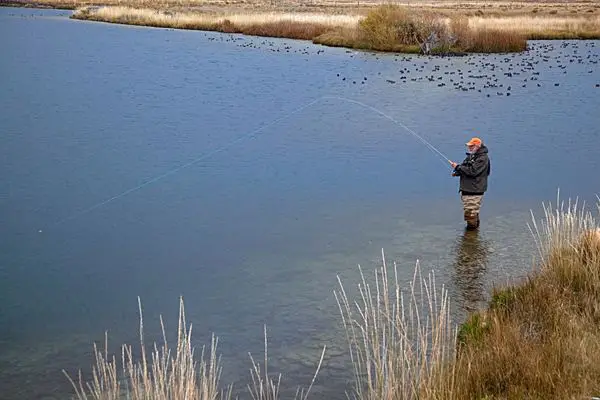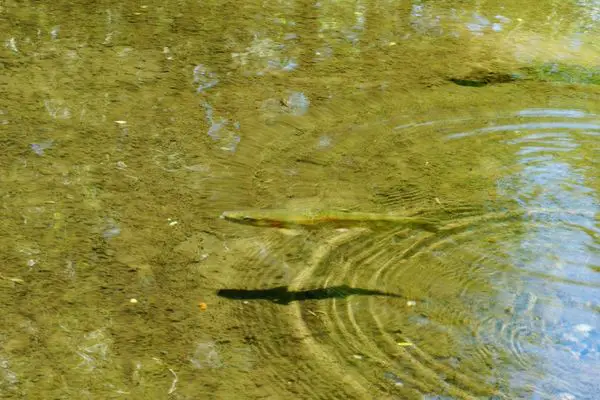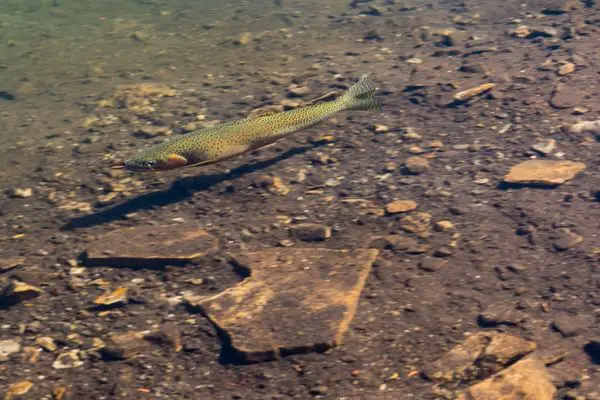Something about fishermen, we often seem to think the most likely place to find fish is in the deepest hole, or on the featureless bottom of a lake several hundred feet down. We know that fish live in water, so deeper water must be hiding bigger fish.
Like most fly fishermen probably already know, this does not apply to trout. It is far from true, trout do enter deep water but when they are there they are not usually feeding, they go there for protection and rest. Resting trout are reluctant to feed, so catching them is difficult. For this reason, targeting deep water can be very slow fishing compared with shallower water closer to shore.
In this article, I will share some tactics and tips on how to best fish for trout in shallow water. I will cover both lakes and rivers.
- If you are wondering just how deep trout go, I have an article here.
- If you want tips on how to fish shallow, overgrown streams check here
- For my advice on the best spinner lures for shallow water check here

Fishing shallow in lakes (Stick to the shoreline)
When fishing from the shore, fly fishermen typically are forced to fish the shallows. The limitations of our equipment mean we simply can not cast far enough to get beyond it.
It is a different story when it comes to bait and spin fishermen. This tackle, when used with enough weight can be cast very far. Over the top of the trout, weedbeds, dropoffs, and into the ‘featureless desert’ beyond.
I see this nearly every time I visit a stock pond, with people casting as far as possible. Then only catching the occasional fish. Meanwhile, there will be an old timer, barely cast 30 feet who will be landing fish after fish.
Some fishermen might copy his bait, or walk and fish beside him. But that is not the secret to his success, he is fishing where the trout, the bait, and location are of secondary importance.
How shallow is too shallow for trout?
I have seen trout so shallow that their fins are nearly out of the water, although fish in such situations are normally highly alert and will dart back to the depths at even the lightest of disturbances.
Two feet or deeper is a good guideline for how shallow trout typically cruise for food. They do chase food into shallower water at times, but in my experience, they are not overly comfortable there.
At night they do seem to be more confident and will spend more time close to shore.
Why do trout stick close to the shore in lakes?
I feel it is important to explain why trout are commonly found in shallow water, within a stone’s throw of the shore. They certainly have thousands, if not millions of gallons to explore further out.
There is more food in the shallows
Will, trout are simple creatures, all they really care about is food, shelter, and reproduction.
The shore and shallow areas of a lake is the most biologically rich section of the lake floor, that is where most of the food grows because the sunlight can reach the bottom simulating plant growth that provides food for aquatic insects, and protection for the fish that prey upon it.
Also in the summer months, a not insignificant amount of food gets blown into the lake from overhanging vegetation. Few trout will turn down an easy meal of wind blown cricket.
Further out, in deep water, there is not much food. The waterweeds no longer grow, so the aquatic insects are gone. So we are basically left with algae and plankton to supply subsistence. Sure trout and baitfish, can feed upon plankton, but it is nowhere near as energy rich. They will much rather spend their energy eating nymphs and snails in the shallows.
Large predatory trout often trap bait fish in the shallows
I see this more often in the evenings, and at night than during the day. Larger trout will hurass and trap shoals of bait between themselves and the shoreline.
The only escape for the bait is to throw themselves up onto the gravel, or to try and dart back out pass the waiting trout. I do not know how long they keep the bait in the shallows, because after observing for a minute or two I nearly always retrieve a streamer right through the middle of the action.
The results is usually an angry brown in only a few inches of water.
The shallows offer a sanctuary for stockfish
Trout are both predators and prey, they hunt smaller animals, but larger fish such as pike, bass or even mature trout will happily predate on them.
For this reason, it is not uncommon to find stock trout shoaling in the extreme shallows. Hiding under and among, tree branches and other structures that have fallen into the lake. There might also be plenty of weed beds they can burrow into.
So for traumatized stock trout, the extreme shallows provide a haven away from the scary bigger fish that patrol closer to the drop-off.

When to fish in shallow water?
Shallow lake water does not always provide the best fishing, but it often does. In this section, I will explain the best times to target trout in the shallows.
During warm winter days
Generally speaking the temperature of deeper water is more stable than shallow water, so on a sunny winter’s day. The warmth of the sun can heat the shallows faster than any other part of the lake. It can even get warm enough to simulate some aquatic insects back into life.
So the trout return to the shallows to feed during the day, because it is temporarily the warmest area of the lake.
Obliviously, the reverse is also true in Summer. When the water temperature is already high, shallow flats can warm quickly forcing the trout into deep water seeking out more comfortable temperatures.
When there are offshore winds during the summer/fall.
Winds during the summer, and fall can blow a lot of insect life into the lake, and most fly fishermen already know how much trout love to eat juicy terrestrial insects. A fat hopper or cicada provides the same amount of calories as dozens of mayfly nymphs.
The trout know this, so will be on the lookout for drowned insects during windy weather.
When there is an onshore chop/waves
Yes, both wind directions can encourage trout into the shallows.
An onshore wind or chop can make casting difficult, plus it is usually fun to fish with the wind in our faces, but all of the wave action is stirring up the bottom, dislodging aquatic insects and disorientating smaller baitfish.
An onshore wind, with a chop, is one of the best times to fish streamers and lures.
Where to fish the shallows?
With an untrained eye, most of the lake looks similar, just a large expanse of water. But under the surface the shoreline can be very diverse, there are submerged beaches, flats, dropoffs, weed banks, and even in some river deltas.
Meanwhile, some places have plenty of overhanging vegetation, while other shorelines are quite spartan.
Shallow flats often hold the most trout
It might not look like it at first glance, but flats often hold an impressive number of trout, the biggest problem is that they can be difficult to approach because there is nothing for the fisherman to stand behind to hide their arrival.
To add to the difficulty, trout rarely stay still on flats, they are usually patrolling around, looking for food. Now trout are creatures of habit, they do not cruise randomly but usually follow a pattern. I like to observe the trout cruising flats to figure out their routine, allowing me to get into position to place a fly on their path when they are not looking towards me.
Drop-offs / Weedbeds offer plenty of food for trout.
When the shoreline is steeper, there is usually a combination of weed banks and rapid dropoffs. Trout like to patrol both.
I suspect trout like drop-offs because they provide the food resources of the weed banks, alongside the relative safety of the drop off. If they sense any danger from above, they can quickly dart away to the safety of the deeps.
River deltas
It is no secret that river deltas, or anywhere a tributary enters a lake are excellent trout habitat.
Deltas typically provide the same benefits as a flat but with moving water that brings food to them. Why would a trout cruise around, when they can just lay there and wait for the food to come to them?
Where do trout hold at river deltas? Trout will typically feed at the edge of the current. They want to grab food drifting by while exerting as little energy as possible.
Overhanging vegetation and structure
The less tidy a shoreline, the more likely it is to hold fish. If there are numerous wind blown trees, chances are trout will be there.
Trout love the shallows, but the main downside is that it does not provide them with much protection from aerial attacks. Luckily, submerged trees protect them from birds.
As I already mentioned above overhanging vegetation provides for a steady supply of terrestrial insects that waiting trout will happily eat up.
When to avoid fishing the shallows?
Sometimes the shallows are not worth fishing, and in these situations, deeper water might prove to be more productive.
1) When temperatures are high
Broadly speaking, if the water temperature is above 68f the trout will not be there.
All other things being equal, shallow water warms quicker than deeper water. When water temperatures are high will go deeper seeking cooler water in the thermocline, or will hang out near cold water tributaries (or their mouth).
What does this mean, trout are unlikely to be found in shallow water on a hot summer day.
2) When people are swimming
If there are numerous people swimming or playing in the water, this suggests two things. That the water is warm, and any trout will likely be long gone or hiding. Fishing is going to be tough.
I suggest moving a few hundred yards further along the lake to water that is less disturbed.
If you really want to fish a swimming beach, I suggest arriving early in the morning, the water will be cooler and chances are no one will be swimming.
3) When you are fishing from a boat with an extremely loud engine
Trout are often quite tolerant towards boats, they do not really comprehend what they are. This or changes, when your boat makes an absolute racket, or unexpectantly large wash. This can cause chaos, and confusion beneath the surface.
I have seen hot spots, become dead after someone roars up to them with their large engine blasting. When approaching the shallows, slow down and just glide in. Better still use a trolling motor or paddles.

